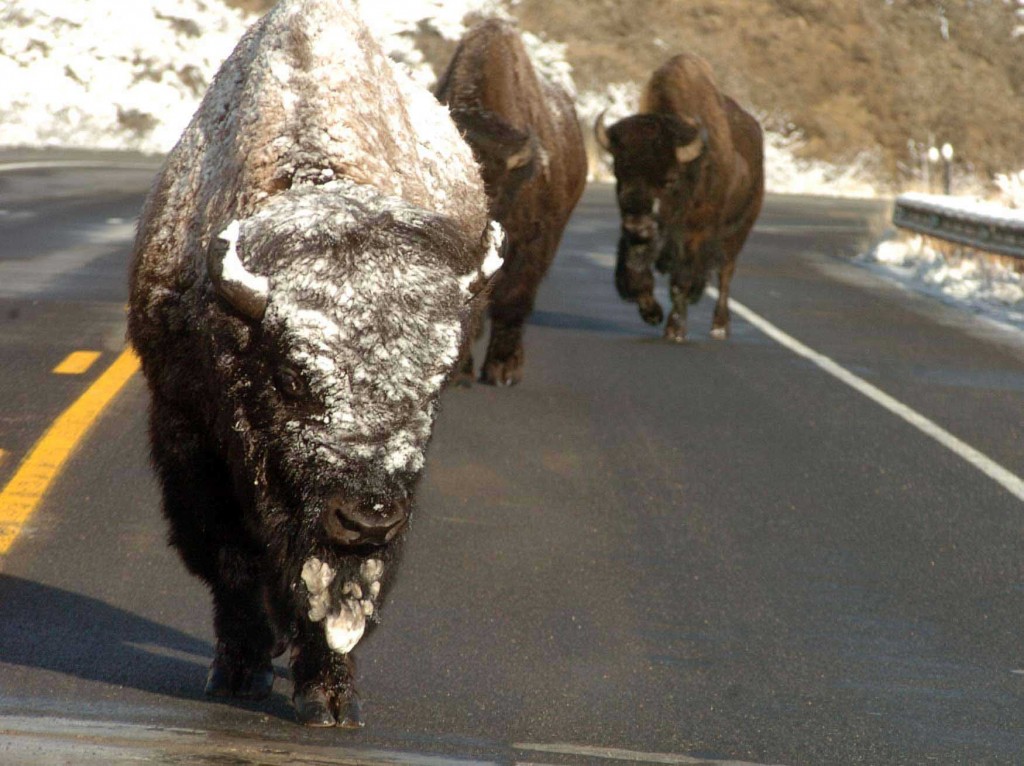
A trio of bison make their way along a highway as they migrate between winter and summer feeding grounds. (Ruffin Prevost/Yellowstone Gate - click to enlarge)
By Ruffin Prevost
Bison migrating out of the North Gate of Yellowstone National Park during cold and snowy weather will have some extra room to roam following a ruling by a Montana judge.
District Court Judge E. Wayne Phillips on Monday dismissed a lawsuit brought by state and local livestock groups that sought to block a plan that would allow bison to move throughout a 70,000-acre “tolerance zone” of mostly federal land north of the park.
State and federal biologists and wildlife managers updated the Interagency Bison Management Plan to allow bull bison to disperse along the Yellowstone River valley between Gardiner, Mont. and Yankee Jim Canyon. The area is primarily U.S. Forest Service land.
Ranchers said they were concerned bison might transmit the disease brucellosis to cattle, and that wildlife managers should keep bison out of the area. Both bison and elk are carriers of brucellosis. A brucellosis outbreak among cattle herds can be financially devastating, requiring widespread livestock quarantine and euthanasia.
National Park Service managers have long struggled with how to handle hundreds of bison moving out of the park along the Yellowstone River during harsh winters when heavy snow and cold temperatures drive the animals to seek milder habitats.
Phillips said in his ruling that state and federal wildlife managers have no specific duty to keep bison away from people, property or livestock to prevent potential unwanted results.
Montana Fish, Wildlife and Parks officials, Phillips said in his ruling, “do not have a statutory duty to ensure that no harm is incurred by a Montana resident by a wild animal. If a duty existed, then FWP would theoretically be liable for any harm carried out by a wild animal in this state.”
“This would encompass deer hit by motorists on state highways, bear maulings occurring outside national parks, mountain lion attacks on children, damage to feed and fields by elk and deer, loss of timber by the busy beaver, and countless more scenarios,” Phillips wrote.
The nonprofit bison advocacy group Buffalo Field Campaign had intervened in the lawsuit in support of the expanded tolerance zone.
Daniel Brister, Buffalo Field Campaign’s executive director, said in a statement released Monday that he was “heartened that migratory bison will have some room to roam their winter range in Gardiner Basin.”
“This case underscores how important local support is for migrating bison. Judge Phillips relied on that local support for bison in his ruling today—an important victory for bison wintering in Gardiner Basin,” Brister said.
Phillips noted in his ruling that he understood the concerns of ranchers in filing the suit, and that “there is certainly a large potential of over-abundance of bison because the Park Service refuses to address bison numbers within the context of their own policy.”
One option being recommended by National Park Service biologists for reducing the disproportionately high levels of bison in Yellowstone’s northern herd is the killing of up to 450 animals, mostly females, this winter.
Selective culling at holding facilities near the park has been politically unpopular in the past and proven to be a public relations disaster for the Park Service.
Montana wildlife officials have said that allowing a limited hunt on federal lands north of the park would be easier after Phillips’ ruling because it would allow bison to disperse over a wider area.
Contact Ruffin Prevost at 307-213-9818 or ruffin@yellowstonegate.com.
